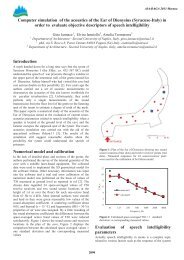ERATO Proceedings Istanbul 2006.pdf - Odeon
ERATO Proceedings Istanbul 2006.pdf - Odeon
ERATO Proceedings Istanbul 2006.pdf - Odeon
Create successful ePaper yourself
Turn your PDF publications into a flip-book with our unique Google optimized e-Paper software.
Table 1. Simulated acoustical parameters averaged over the 500-1000 Hz 1/1 octave<br />
frequency bands for the Aspendos Roman theatre with audience and averaged over<br />
15 receiver positions in different configurations.<br />
Theatre<br />
Configuration<br />
Acoustical Parameters<br />
T 30 (s) G (dB) C 80 (dB) STI DL2 (dB)<br />
Reference model 1,81 -4,02 5,43 0,63 4,80<br />
Flat Stage Wall 1,78 -4,81 4,82 0,61 5,31<br />
No Stage Wall 1,22 -8,11 10,57 0,81 6,82<br />
No Stage Reflector 1,69 -4,87 6,87 0,68 4,83<br />
No Colonnade 1,41 -4,50 6,67 0,66 5,79<br />
Absorbing Orchestra 1,70 -4,95 5,26 0,63 4,03<br />
In table 1 are shown the overall differences of the modified theatre models compared to the<br />
reconstructed reference model at mid-frequencies.<br />
By using a flat stage wall without diffusing geometries it is seen that the overall strength level G is<br />
reduced and the DL2 rate is increased. By removing the geometries of the stage wall the sound field<br />
in the theatre becomes less diffuse and more dominated by specular reflections. These dissipate<br />
quicker through the open roof resulting in a lower sound level in most of the seats.<br />
By removing the stage wall it is seen that the reverberation time decreases dramatically resulting in<br />
a substantial increase of clarity and STI but in detriment of the strength level.<br />
Without stage wall few early reflections from a vertical surface reach the receivers. The sound<br />
propagates in a similar way to free field conditions and this is exemplified by the level decay per<br />
distance doubling which is about 6 dB.<br />
3.2 Aphrodisias <strong>Odeon</strong><br />
T30 (s)<br />
3,5<br />
3,0<br />
2,5<br />
2,0<br />
1,5<br />
Ref model<br />
Flat ceiling<br />
Closed<br />
windows<br />
Absorptive<br />
Orchestra<br />
1,0<br />
0,5<br />
0,0<br />
63 125 250 500 1000 2000 4000 8000<br />
Freq (Hz)<br />
Figure 5. Simulated reverberation time T 30 as a function of 1/1<br />
octave frequency bands averaged over 15 receiver positions in<br />
different configurations.<br />
24
















